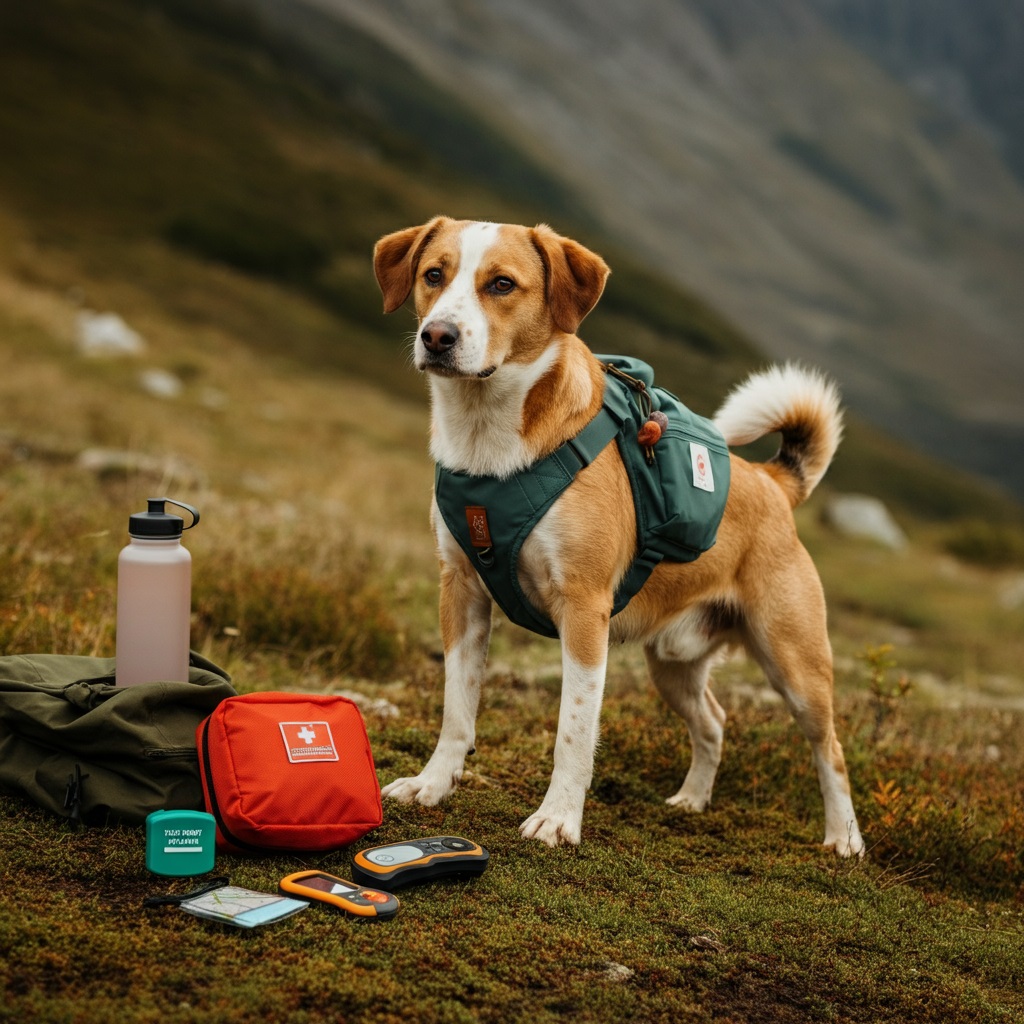
Taking your furry friend on outdoor adventures creates lasting memories and strengthens your bond. Whether you’re planning a day hike through mountain trails, a weekend camping trip, or exploring a new city together, having the right gear packed in your pet’s backpack can make the difference between a successful adventure and a stressful experience.
A well-prepared pet backpack serves multiple purposes beyond just carrying supplies. It helps distribute weight evenly across your pet’s body, gives them a sense of purpose and job to do, and ensures you have everything needed to keep them safe, comfortable, and happy throughout your journey. The key lies in knowing what to pack for different types of adventures while keeping your pet’s specific needs, size, and energy level in mind.
This comprehensive guide will walk you through the essential items every pet adventure backpack should contain, help you choose the right gear for different activities, and provide practical tips for training your pet to wear and enjoy their backpack. By the end, you’ll have the knowledge to pack like a pro and embark on countless adventures with your four-legged companion.
Choosing the Right Backpack for Your Pet
Before diving into what goes inside the backpack, selecting the proper pack for your pet’s body type and adventure style is crucial. Dog backpacks come in various sizes, styles, and capacities, each designed for different activities and dog breeds.
Size and Fit Considerations
The backpack should fit snugly around your dog’s chest and back without restricting movement or causing chafing. Measure your pet’s chest circumference at the widest point and their back length from the base of the neck to the base of the tail. Most quality backpacks include detailed sizing charts to help you find the perfect fit.
A properly fitted backpack will have adjustable straps around the chest and belly, with padding at pressure points. The pack should sit comfortably on your dog’s back without sliding forward onto their neck or backward toward their hindquarters. Your pet should be able to sit, lie down, and move naturally while wearing the pack.
Weight Capacity Guidelines
As a general rule, healthy adult dogs can carry 10-12% of their body weight in their backpack. For example, a 50-pound dog can safely carry 5-6 pounds of gear. Puppies, senior dogs, or pets with health conditions should carry less weight or no weight at all. Start with an empty or lightly loaded pack to help your pet adjust before gradually adding weight.
Consider your adventure’s duration and intensity when calculating weight limits. A short day hike allows for more weight than a multi-day backpacking trip where your pet will be carrying the load for extended periods.
Water and Hydration Essentials
Proper hydration ranks as the most critical aspect of pet safety during outdoor adventures. Dogs regulate their body temperature primarily through panting, which increases their water needs significantly during physical activity.
Water Storage Solutions
Pack more water than you think you’ll need. A good rule of thumb is to bring at least one ounce of water per pound of dog per day for moderate activity, with additional water for hot weather or strenuous exercise. Collapsible water bottles designed for pets save space and weight while providing easy access to fresh water.
Collapsible silicone bowls are lightweight, pack flat, and make drinking easier for your pet than trying to drink directly from a bottle or stream. Some pet backpacks include built-in hydration systems with tubes that allow your dog to drink while wearing the pack.
Electrolyte Considerations
For longer adventures or hot weather conditions, consider packing electrolyte supplements designed specifically for dogs. These help replace minerals lost through excessive panting and can prevent dehydration-related health issues. Always consult your veterinarian before introducing new supplements to your pet’s routine.
Food and Nutrition on the Trail
Maintaining your pet’s energy levels and nutrition during adventures requires careful planning and the right supplies.
Portable Food Options
Pack lightweight, nutrient-dense foods that won’t spoil in varying temperatures. Freeze-dried dog food works excellently for multi-day trips, while high-quality kibble or dehydrated treats suffice for day adventures. Portion meals into individual servings using resealable bags to prevent overpacking and make feeding time more convenient.
For longer trips, consider foods with higher calorie density than your pet’s regular diet to account for increased energy expenditure. Many adventure-specific dog foods are formulated with extra protein and fat to fuel active dogs.
Treat Strategy
High-value treats serve multiple purposes during adventures. They provide quick energy boosts, help with training reinforcement, and can be used to motivate your pet during challenging portions of the journey. Pack treats in waterproof containers to prevent moisture damage and maintain freshness.
First Aid and Safety Equipment
A well-stocked first aid kit tailored to your pet’s needs can handle minor injuries and provide critical care until you can reach veterinary help.
Basic Medical Supplies
Include gauze pads, medical tape, antiseptic wipes, and tweezers for removing splinters or thorns. A digital thermometer helps monitor your pet’s temperature, while a small bottle of saline solution can clean wounds or flush debris from eyes.
Pack any prescription medications your pet takes regularly, plus a few extra doses in case your trip extends longer than planned. Store medications in waterproof containers with clear labels indicating dosage and administration instructions.
Protective Gear
Depending on your adventure destination, protective gear might be essential for your pet’s safety and comfort. Booties protect paws from hot pavement, rough terrain, salt, or snow. Start with short wearing sessions at home to help your pet adjust to the feeling of booties before your adventure.
A lightweight LED collar or clip-on light improves visibility during early morning, evening, or emergency situations. Reflective gear becomes crucial if you’re hiking in areas with vehicle traffic or if your pet tends to wander.
Weather Protection and Comfort Items
Weather conditions can change rapidly during outdoor adventures, making weather protection gear essential for your pet’s comfort and safety.
Temperature Regulation
For cold weather adventures, pack a lightweight insulated jacket or vest sized appropriately for your pet. Look for gear that doesn’t restrict movement but provides core warmth. In hot conditions, cooling bandanas or vests can help prevent overheating.
A compact emergency blanket takes up minimal space but provides crucial warmth and wind protection if weather conditions deteriorate unexpectedly. These space blankets can also serve as ground covers for rest breaks or emergency shelters.
Rain and Moisture Protection
A lightweight rain jacket keeps your pet dry and comfortable during unexpected weather changes. Choose waterproof gear with breathable fabric to prevent overheating. Some pet rain gear includes reflective elements for additional safety.
Continues after advertising
Pack a quick-dry towel for wiping down wet or muddy paws and fur. Microfiber towels are lightweight, absorb significant amounts of water, and dry quickly between uses.
Navigation and Communication Tools
Keeping track of your pet and maintaining communication capabilities ensures safety during adventures in unfamiliar territory.
GPS and Tracking Options
A GPS tracker attached to your pet’s collar provides real-time location information if they become separated from you. Many modern pet trackers include features like activity monitoring, safe zone alerts, and long battery life suitable for extended adventures.
Traditional ID tags remain important backup identification. Include your name, phone number, and relevant medical information about your pet. Consider temporary tags with local contact information if you’re traveling far from home.
Emergency Communication
Pack a whistle for emergency signaling and a fully charged portable phone charger to ensure your communication devices remain functional throughout your adventure. Some areas with poor cell coverage benefit from satellite communication devices for true emergency situations.
Adventure-Specific Gear
Different types of adventures require specialized equipment to ensure your pet’s safety and enjoyment.
Hiking and Backpacking
For hiking adventures, include paw protection, extra food for increased calorie burn, and lightweight camping gear if your pet will be sleeping outdoors. A compact sleeping pad provides insulation from cold ground and adds comfort for your pet’s rest.
Trekking poles or hiking sticks aren’t just for humans – they can help you assist your pet over challenging terrain or provide stability when helping them navigate obstacles.
Water Adventures
Swimming and water activities require specialized safety equipment. A properly fitted life jacket provides buoyancy and safety even for strong swimming dogs. Bright colors and reflective elements improve visibility in water environments.
Pack fresh water for drinking, as salt water, lake water, or streams may contain harmful bacteria or parasites. A long lead or waterproof GPS tracker helps maintain control and contact with your pet around water.
Urban Exploration
City adventures present unique challenges requiring different gear. Booties protect paws from hot pavement and urban debris. A shorter leash provides better control in crowded areas, while waste bags are essential for responsible pet ownership.
Include documentation like vaccination records and city-specific licenses if required. Some urban areas have specific regulations about pets in public spaces.
Training Your Pet to Use a Backpack
Successfully introducing your pet to wearing and carrying a backpack requires patience and gradual conditioning.
Introduction Process
Start by letting your pet investigate the empty backpack at home. Allow them to sniff, examine, and become comfortable with the pack before attempting to put it on. Positive associations with treats and praise during this introduction phase set the foundation for success.
Begin by having your pet wear the empty pack for short periods around the house. Gradually increase wearing time as they become more comfortable. Most pets need several days to weeks of conditioning before they’re ready for adventure-length wear.
Weight Training Progression
Once your pet comfortably wears the empty pack, begin adding small amounts of weight gradually. Start with just a few ounces and increase slowly over several training sessions. Watch for signs of discomfort, excessive panting, or changes in gait that might indicate the pack is too heavy or doesn’t fit properly.
Practice walking with the loaded pack in familiar environments before venturing into new territory. This helps your pet adjust to the weight distribution and movement of the pack while building confidence.
Packing Tips and Organization
Efficient packing maximizes space while keeping essential items easily accessible during your adventure.
Weight Distribution
Balance weight evenly between both sides of the pack to prevent strain or discomfort. Place heavier items closer to your pet’s center of gravity, typically over their shoulders and back rather than toward the rear of the pack.
Keep frequently needed items like water, treats, and first aid supplies in easily accessible compartments. Items needed only in emergencies can go in less accessible areas.
Waterproofing Strategy
Even waterproof backpacks benefit from additional moisture protection for critical items. Use dry bags or waterproof pouches for electronics, medications, and food. This double protection ensures your supplies remain functional even in extreme weather conditions.
Seasonal Considerations
Different seasons require adjustments to your pet’s adventure backpack contents and preparation approach.
Summer Adventures
Hot weather demands extra water, electrolyte supplements, and cooling gear. Plan for earlier start times and longer rest breaks in shaded areas. Paw protection becomes crucial on hot pavement or sand.
Monitor your pet closely for signs of overheating, including excessive panting, drooling, or lethargy. Pack cooling towels and know the locations of veterinary clinics along your adventure route.
Winter Conditions
Cold weather adventures require insulation, paw protection from snow and ice, and higher calorie foods to fuel your pet’s increased energy needs for staying warm. Ice cleats or special winter booties provide traction on slippery surfaces.
Pack extra layers and emergency warmth supplies. Shorter daylight hours mean carrying lighting equipment and planning routes with sunset times in mind.
Read More👉 Pet Startups Revolutionizing Animal Wellness
Making Every Adventure Memorable
A well-packed pet backpack transforms ordinary outings into extraordinary adventures. The key lies in matching your preparations to your specific adventure type, your pet’s individual needs, and the environmental conditions you’ll encounter.
Remember that your pet’s safety and comfort should always take priority over ambitious adventure goals. Start with shorter, easier adventures to build both your confidence and your pet’s endurance and enthusiasm for outdoor activities.
Regular practice with packing, unpacking, and using your adventure gear at home ensures smooth experiences when you’re in remote locations. Take time to inspect and maintain your pet’s backpack and gear between adventures, replacing worn items before they fail during critical moments.
The investment in proper gear and preparation pays dividends in the form of countless memories and shared experiences with your loyal adventure companion. Every trail becomes more enjoyable when you know you’re prepared for whatever challenges and discoveries await around the next bend.



